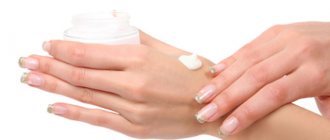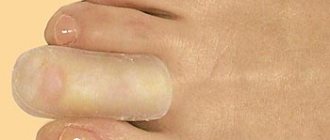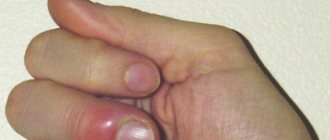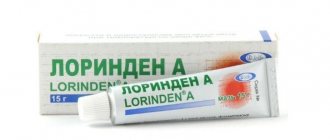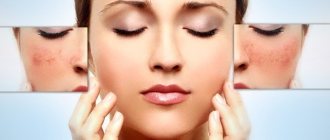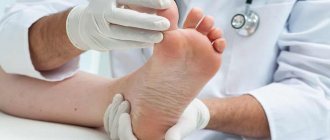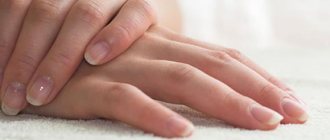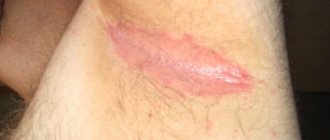Causes of foot fungus
The causes of the pathology may be the following:
weakening of the protective mechanisms of the human body due to past inflammatory or infectious diseases;- insufficient blood supply to the lower extremities, provoking stagnant processes;
- microdamage to the skin and sores in the feet and toes;
- active sweating or excessively dry epidermis;
- wearing tight or uncomfortable shoes for a long time.
The appearance of fungus can also be caused by a banal failure to comply with the rules of personal hygiene and diaper rash. In addition, the infection can enter the human body through microtraumas on the skin when visiting a sauna or swimming pool.
What are the symptoms
The skin between the small toes will usually be affected first. The first signs of fungus, when the infection has just formed on the skin, are minor. The onset will become noticeable when the rash begins to spread and the skin begins to become itchy and scaly. Cracks and inflammation will appear on it. Large cracks in the skin between the toes may become larger and may be very painful. Tiny flakes of infected skin will peel off.
If interdigital mycosis is left untreated, the rash will gradually spread along the entire leg. In some cases it extends to the sole. Often the infection causes peeling on the entire sole and sides of the foot. Sometimes mycosis causes large blistering rashes throughout the sole. In this case, we are dealing with foot fungus.
Symptoms and stages of disease development
Mycosis is characterized by several stages of development, each of which manifests itself differently. Signs of the initial stage: the appearance of cracks, especially under the little toe and on the feet; peeling of the skin in the area of cracks that have appeared.
At the initial stage, the symptoms of the disease are not very pronounced, for this reason most people do not pay special attention to these manifestations, provoking further development.
The next degree has more characteristic symptoms. Red spots and severe peeling appear on the surface of the skin . At the same time, bubbles may appear containing lymphatic fluid. They may appear as cloudy semicircular formations.
At the second stage of development of the disease, corns and calluses form , and the skin becomes rougher. This causes itching and burning.
At the penultimate stage of mycosis, the condition of the skin noticeably worsens. The cracks deepen, turning into erosion. The fungus becomes wet. Along with these signs, others also appear: swelling and inflammation of the affected areas .
In the presence of an advanced stage, the following symptoms are observed:
- The appearance of blisters with pus on the skin, especially on the feet and under the little toe.
- Itching and pain intensify.
- The skin becomes very irritated and red.
Cutaneous mycosis between the fingers - how does the disease occur?
Cutaneous mycosis is an infectious disease caused by parasitic fungi on the skin. They can appear on any part of the body. But most often they choose folds of skin. The spaces between the toes are their favorite place. This is due to the fact that feet sweat quite often, and in tight shoes the moisture does not have time to evaporate. Therefore, the spaces between the toes are often damp and damp. And these conditions are exactly what the fungus needs to reproduce. Often the fungus gets into the grooves between the fingers from infected nails.
Contribute to the development of skin diseases:
- insufficient foot hygiene, overheating or hypothermia;
- predisposition to increased sweating;
- poor blood circulation in the foot associated with heart disease, smoking, diabetes;
- stress;
- calluses and cuts on the skin of the feet;
- lack of vitamins (A, C) and mineral elements (primarily zinc) in the body;
- trophic ulcers on the leg;
- hormonal imbalance and thyroid diseases;
- overweight;
- excessively dry skin.
However, in most cases, fungus between the toes does not develop if the person has a healthy immune system.
The disease is more common in men, due to their more frequent wearing of tight shoes. Fungus on the feet can appear not only in adults, but also in children.
Skin mycoses between the toes in 90% of cases are caused by the activity of three types of fungi from the group of dermatomycetes - Trichophyton, Microsporum, Epidermophyton. Also, the skin in the spaces between the fingers is often affected by fungi of the genus Candida.
Most often, the infection initially develops in the cavity between the two smallest toes. However, other interdigital spaces may also be affected. Once on the skin, the fungus actively multiplies on it. The remains of the stratum corneum of the skin serve as food for microorganisms.
The skin infection can be spread from person to person. For this, simple contact of the skin of the feet with surfaces containing fungus is sufficient. Transmission of the pathogen can occur through someone else's shoes, socks, shared towels, or wet shower floors. It is necessary to carefully monitor personal hygiene and use only personal items. In swimming pools, showers, baths and saunas you should use personal or disposable slippers and flip-flops.
Photo: ArtTower / Pixabay.com
Often, a skin disease is transmitted from one family member to another, when using the same shoes, pedicures, socks, towels, when walking around the house barefoot, etc.
Symptoms of fungal infection on the skin of the feet
Symptoms of mycosis of the feet at an early stage:
- itching and burning, worse at night;
- dryness;
- peeling of the skin;
- small cracks.
As the disease develops, the symptoms intensify, the itching and burning become unbearable, leading to scratching and irritation of the skin, and the cracks become deeper. The skin of the feet becomes rough. Pain appears, an unpleasant odor that does not go away even after washing, swelling and hyperemia, and detachment of the epidermis is observed.
Then blisters filled with serous fluid appear. After opening them, non-healing festering ulcers remain on the skin. A bacterial infection joins the mycotic infection.
Peeling of nails and abscesses may occur. A complication of mycosis of the feet can be the penetration of the fungus into the blood and the spread of infection throughout the body. At the same time, the body temperature rises. Gangrenous lesions of the feet may also develop. The course of skin disease is complicated by cardiovascular diseases, immunodeficiency states, and diabetes mellitus.
To diagnose mycosis of the feet, it may not be enough for a doctor to examine the skin. It is often necessary to analyze the composition of the skin microflora. To do this, a scraping is taken from the affected surface. The fungus can be on the skin even in the absence of visible symptoms of infection.
There is also a folk method for determining the presence of fungus on the foot. To do this, you need to place your foot in a bath with potassium permanganate. If there is no fungus on the skin, it will turn pink, and the affected areas will turn white.
Treatment of fungus between toes
Skin fungus requires long-term and proper treatment. You can carry out effective therapy on your own at home.
The most important thing is to undergo diagnostics so that this diagnosis is confirmed. Only after this can you think about how to treat toenail fungus between the toes.
Complex treatment of mycosis of the feet and skin between the toes is based on the use of traditional medicine and medications.
Medications
Terbinafine is considered the most effective remedy to cope with mycosis. This drug allows you to say goodbye to the fungus in just a month. The daily dosage of the drug should not exceed 260 mg.
Another effective antifungal agent is Itraconazole . It should be used for one and a half to two weeks. Daily dosage: two tablets.
Therapy with antifungal drugs for internal use should be supplemented with external agents (ointments, creams, etc.).
Drug treatment
If the skin between your fingers itches or signs of inflammation appear, you should consult a doctor.
The photo shows that the manifestations of the fungus are similar to the symptoms of dermatitis, so only a specialist can accurately diagnose the disease and prescribe treatment.
At home, effective remedies are used in tablet form and ointments with an antifungal effect. List of the most popular pharmaceutical drugs against mycosis:
- Griseofulvin (ointment, suspension, tablets). It is taken orally and applied to problem areas of the body, which helps to quickly get rid of the disease. The duration of therapy is determined by the doctor, based on the severity of the patient’s condition.
- Terbinafine. A good drug that helps in the fight against a large number of pathogenic microorganisms.
- Fluconazole. Available in the form of tablets, syrup, capsules. In especially severe cases, it can be used for intravenous administration.
- Clotrimazole. Fights most types of fungal infection, which has many dosage forms - cream, spray, ointment, lotion.
- Sertaconazole. An effective anti-fungal cream, which is recommended to be applied to problem areas of the body at least twice a day.
Treatment of any form of mycosis should take at least a month, which guarantees a lasting positive result.
How to treat mycosis in children
Fungus on the feet can appear in people of any age. The causes of peeling and irritation of the skin can be determined by a dermatologist. These could be microtraumas or malfunctions of the immune system.
One of the most effective drugs is considered to be an ointment for foot fungus called Terbinafine . It can be taken by children from two years old. You can get rid of mycosis in several sessions: a week and a half of taking it and the same amount of time off. And so two or three times.
At the initial stage, external therapy (cheap ointments like Exoderil and Mycoterbin) is sufficient for the child. The advanced form must be treated with a combination of antibacterial and antifungal drugs: Exoderil, Triderm and Travocort .
Traditional treatment
There are many effective recipes that are aimed at eliminating fungal infections and are a salvation during pregnancy, breastfeeding, for the treatment of children and for individual intolerance to drugs.
To eliminate fungus on the toes, use:
- Compresses based on birch tar - steam your feet in warm water, rub birch tar into the damaged areas, apply the composition liberally to the area between the toes, cover with a napkin. After 2 hours, remove the remaining mixture. Do not wash your feet for 2 days. Repeat the procedure 5 times. In the initial stage, the fungus can be completely eliminated without the use of medications.
- Celandine oil is an additional medicinal product, used for massage before bed, the course of treatment lasts about 4 weeks.
- Bath with soda and salt - take equal amounts of the components, add hot water to a container, soak your feet for 15 minutes, then lightly dry the skin with a towel. Do the procedure once a day, before bedtime.
- Vinegar lotions - moisten a cotton swab in a 9% solution and apply to the affected areas, especially in the area of the little finger and ring finger, where the symptoms of the disease most often worsen. After 5 minutes, rinse your feet in warm water. Afterwards, you can apply antifungal ointments.
- Iodine bath - dilute a liter of water with a teaspoon of iodine, keep your feet in a warm solution for 20 minutes, then you can rinse with a herbal decoction consisting of burdock, wormwood, and plantain. Brew in the classic way - add a spoonful of raw materials to a glass of water, boil for 5 minutes in a water bath.
Folk remedies for fungus between fingers
In the treatment of fungus between the fingers, a recipe with ground coffee is actively used - 5 tablespoons of the main medicinal component are dissolved in a liter of water. The liquid is poured into a basin, where the legs are lowered for 30 minutes. The course of the procedure is every day for a month.
Attention!
In the summer, the herb wormwood will help get rid of mycosis of the feet. Prepare a decoction - 0.5 kg of the above-ground part of the plant for 3 liters of water. Boil for 15 minutes. Cool. Soak your feet before bed. Therapeutic course – 3 weeks.
The bee product also helps effectively - wipe your feet dry, cover the area between the toes with propolis, put on socks, and after 5 hours remove the remaining composition. Improvement will occur in 2 months.
Preventive measures
It’s easy to pick up a fungus, but dealing with this trouble is not so easy. Proper prevention allows you not only to say goodbye to the disease, but also to avoid relapses:
- Compliance with personal hygiene rules. Regular washing of hands and feet, timely and proper treatment of diaper rash, combating excessive sweating.
- Be careful in public places. It is recommended to visit swimming pools and baths, taking a change of shoes with you. After water procedures, it is advisable to treat your feet with ordinary hydrogen peroxide or antifungal agents.
- Use comfortable and loose shoes, timely removal of corns and calluses.
- Vigorous activity that improves blood flow in the legs.
If there is already a person in your family who is faced with a fungus problem, then their shoes and personal hygiene items must be thoroughly disinfected . After taking a bath, the limbs need to be treated with special compounds that disinfect the skin.
At the first appearance of signs of mycosis, you should immediately visit a dermatologist , who will make a diagnosis and prescribe suitable treatment therapy. If the disease is detected in time, it will be easier to cope with.
Originally posted 2018-01-31 08:31:20.
Prevention
To avoid infection or recurrence of the problem, dermatologists recommend following simple but effective rules of prevention:
- Pay special attention to your health and promptly treat any infectious, viral or endocrine diseases.
- Increase immunity through hardening and physical exercise, and also do not forget about the need to take vitamin complexes.
- Try not to visit swimming pools, baths, saunas or public locker rooms without rubber shoes or slippers.
- Maintain good hygiene and wash your feet daily with warm water and soap.
- Regularly wash socks and treat shoes with antifungal agents that protect against mycosis.
- Do a pedicure every 2-3 weeks with pre-disinfected tools.
- Do not wear other people's shoes or socks and do not allow other people to use your personal belongings.
Modern pharmaceuticals offer a large selection of drugs to combat fungal infections and eliminate the unpleasant symptomatic manifestations of mycosis.
To quickly get rid of fungus between the fingers, you must strictly follow the instructions of your dermatologist and not stop the therapeutic course ahead of time - this will help speed up the healing process and prevent the development of complications.
Features of treatment in children
Any child can get fungus between their toes. Even a cured adult can provoke the development of an infection if there are objects in the house that have not been disinfected. A competent doctor will tell you how to cure a fungus for your baby. Children with an infected pinky or other finger cannot use the same medications recommended for adults.
If you suspect a fungus in a child, you should contact a dermatologist. He will determine the cause of the disease and select a safe and at the same time effective treatment for it.
Terbinafine was developed to treat children from fungal infections. It is suitable for children from 2 years old. To get rid of the disease, you need to undergo a full course of therapy, which is carried out over 10 days. Afterwards a break is taken and the course is repeated. This treatment regimen is quite effective. In addition, it is suitable for most young patients.
If the child’s fungus is not advanced, then you can limit yourself exclusively to local remedies. He can be treated with Mycoberbine or Exoderil. If the pathology is advanced, then the course of treatment will have to include more serious antifungal and antibacterial medications, for example, Triderm or Travocort.
Symptoms of the disease and its types
If an arm or leg is affected by a fungus, it will manifest itself as follows:
- The skin takes on a reddish tint (the first symptom).
- Increased peeling of inflamed areas.
- Increased dryness of the skin between the fingers, which is why cracks of different sizes begin to appear.
- Constant itching.
- Moving your fingers causes pain.
- White, hard-to-touch furrows form on the surface of the epidermis.
- Small bubbles appear, inside of which there is a clear or cloudy liquid.
- The skin begins to burst in some places, and then gradually peels off.
Dermatologists name three types of fungus that settles between the fingers:
- filamentous fungus or so-called sporotrichosis . It begins to develop after the mycelium of a filamentous fungus or sporothrix enters the body;
- candidiasis . This type of disease is caused by the yeast-like fungi Candida;
- yeast mycosis . A common type of mycosis that develops into a complex form in a short period of time.
Photos on the Internet or specialized printed publications depict signs of different types of pathology.
Thanks to this, you can independently distinguish the development of the fungus, so that you can consult a doctor in a timely manner.
How to cure interdigital fungus?
Even if all these symptoms come after many years, you need to start treating fungus between the toes right away, because it is a highly contagious and difficult-to-treat infection.
Let's go to the dermatologist. Before treatment, he scrapes the fingers and examines it using microscopy, culture or DNA analysis. Microscopy reveals threads of mycelium or spores.
Systemic treatment consists of taking tablets or capsules with antimycotics. They accumulate in the horny tissues, entering through the blood, and destroy the fungus for many weeks after taking the drug
Disadvantage - systemic drugs are moderately hepatoxic (have a bad effect on a weak liver), and therefore treatment cannot be used by people with a diseased liver, pregnant, lactating, young and old. The type of medicine depends on the nature of the pathogen. If the symptoms are unclear and the type is not established, treatment with a broad-spectrum drug is prescribed. The use of systemic medications is still a risk; in advanced stages, they need to be treated for a long time.
You can also treat with local drugs that are applied to the lesions. Such drugs often have a wide range of effects, killing both fungi and bacteria. The treatment is long and intensive, so you should tell your doctor right away if your funds are limited.
Home therapy and prevention of fungal infections . It is useless to treat the fungus yourself. The information suggests its exceptional survivability and high relapse potential.
Folk remedies
Medicinal compositions of this category are used as aids in complex treatment and for preventive purposes. An independent healing effect can be provided if mycosis between the toes has not passed the early stage. The necessary compositions can be prepared from improvised means at home, usually salt or soda for baths, various herbal mixtures with additives.
More on Med-Gribok.Ru:
Inexpensive but effective drugs for the treatment of foot fungus
Salt and soda baths
A popular and accessible method for prevention and quick recovery when the first disturbing symptom is detected. The simplest recipe will require a liter of water heated to body temperature, two tablespoons of salt or soda. After stirring until completely dissolved:
- the feet are lowered into the container;
- hold for up to 30 minutes;
- steamed legs cleanse the compaction of dead particles of the epidermis.
Steaming is carried out at least once a day, preferably at night. If interdigital mycosis is suspected, it can be combined with ointments and other external medications until complete recovery.
Herbal baths
For these purposes, fresh or dry home-made preparations and their pharmacy analogues can be used. Typically, a decoction is prepared from a mixture of dried celandine diluted with chamomile and plantain:
- three tablespoons are poured into a liter of boiled water;
- feet are held for at least 20 minutes;
- cleanse the epithelium of dead particles.
The procedure is suitable for prevention and in the initial stage of mycosis until complete cure.
Lotions with vinegar
The necessary elements for such lotions are a 9% vinegar solution, a pack of cotton pads, and 2 polyethylene bags. Execution sequence:
- moistened swabs are applied to the affected areas and, if necessary, fixed with adhesive tape;
- Prepared bags are placed on the feet and tightened at the neck;
- stand for up to 5 minutes;
- After removing the pacts and used tampons, the skin is washed with warm running water.
To disinfect steamed areas, it is useful to use iodine in a weak solution or hydrogen peroxide. Novocaine can be used, which soothes itching and relieves burning.

